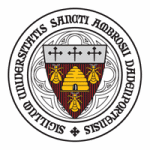Saint Ambrose University
 |
|
| Motto | Faith Learning Justice |
|---|---|
| Type |
Private, Roman Catholic Coeducational liberal arts |
| Established | 1882 |
| Affiliation | Roman Catholic Diocese of Davenport |
| President | Sr. Joan Lescinski |
|
Academic staff
|
350 |
|
Administrative staff
|
314 |
| Students | 3,607 |
| Undergraduates | 2,743 |
| Postgraduates | 864 |
| Location |
Davenport, Iowa, U.S. 41°32′N 90°35′W / 41.54°N 90.58°W |
| Campus | Small city |
| Colors | Navy blue and white |
| Nickname | Fighting Bees/Queen Bees |
| Affiliations | National Association of Intercollegiate Athletics |
| Website | www |
St. Ambrose University is a private, coeducational, liberal arts university affiliated with the Roman Catholic Diocese of Davenport. It is located in a residential area of Davenport, Iowa, United States.
St. Ambrose was founded as a seminary and school of commerce for young men in 1882, known as St. Ambrose Academy. It owes its beginning to the first bishop of Davenport, The Most Reverend John McMullen, DD, who founded it under the auspices of the Diocese of Davenport. The affiliation remains strong today.
For its first three years, classes were held in two rooms of the old St. Marguerite’s School, located on the grounds of what is now Sacred Heart Cathedral in Davenport. Bishop McMullen died in 1883, and Reverend "A.J." Aloysius Schulte, a mere 23 years old, was named St. Ambrose’s first president.
The school was moved to Locust Street in 1885, where the central part of the present-day Ambrose Hall was built. Located in a secluded grove of oak trees, the site was far removed from the city itself. That same year, St. Ambrose was incorporated as “a literary, scientific and religious institution.” The articles of incorporation stated, “No particular religious faith shall be required of any person to entitle him to admission to said seminary.”
By the start of the 20th century, a clearer division was being made between the high school academy and the college program. In 1908, the name of the institution was officially changed to “St. Ambrose College” to more clearly reflect the institution's mission. Night school classes were inaugurated in 1924, and the first session of summer school was held in 1931.
...
Wikipedia
